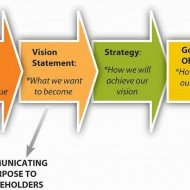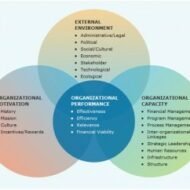Posted by Managementguru in Glossary, Strategy
on Mar 5th, 2015 | 0 comments

The following is a list of “Key Terms of #Strategic Management” which find their use often when trying to explain the concepts. #Mission An important undertaking that an organization believes it is its duty to do. A specific task or duty assigned to a person or group of people. Missions tend to be long-term and laid out in broad terms, without attempts being made to quantify them precisely. #MISSION STATEMENT Mission statement An open statement of the aims and #objectives of a business or an organization – providing employees with an indication of what they are attempting to achieve through their collective deeds. Mission statements are intended to give substance to the perceived purposes of the organization. Vision Statement A Vision Statement defines what your business will do and why it will exist tomorrow and it has defined #goals to be accomplished by a set date. A Vision Statement takes into account the current status of the organization, and serves to point the direction of where the organization wishes to go. Objective Something which an organization intends to do or achieve; a result that the organization intends to make happen. Long-term or short-term objective, which you hope to achieve within a few years or a few months. Objectives and aims tend to be medium-term and more specific in terms of what is intended to be achieved. SMART OBJECTIVES #Strategy A #plan of future action, usually long-term, in the pursuit of objectives. (e.g.) business strategy; company strategy; financial strategy. The formulation of long-term plans and policies by a firm which inter-connects its various production and marketing activities in order to achieve its business objectives. STRATEGY GENERATION #Aim A result that an organization’s plans or actions are intended to achieve. (e.g.) To try to do something: we aim to be No. 1 in the market in three years’ time. Goal An organization’s aim, objective or purpose. Goals and targets tend to be medium-term or short-term and may be expressed in terms of specific levels of achievements and tend to involve more specific quantification and deadlines. (e.g.) our goal is to break even within twelve months. GOALS VS. OBJECTIVES #Target A level or situation which an organization intends to achieve or aim at. An object or area aimed at the object of an attack or takeover bid. A fixed goal or objective, etc. #Tactics The plans followed to achieve a particular short-term aim. (a) The science and art of disposing and maneuvering forces in combat. (b) The art or skill of employing available means to accomplish an end. (c) A system or mode of procedure TACTICS OR STRATEGY? Plan A set of decisions about how an organization intends to do something, or to ensure that an event or result should happen in the future. Organized way of doing something: contingency plan, government’s economic plans. Plans tend to be quite specific (the shorter-term they are, the more specific they tend to be) and are usually quantified in some detail. They will, in order to ensure that they are complied with, lay out specific deadlines for each key stage. They may also involve the consideration or analysis of priorities and constraints. STRATEGIC PLANNING #Budget A #financial plan, which may be short-term or longer-term, showing probable (planned) #income and #expenditure. Budgets tend to be expressed mainly in monetary terms, although they may focus on the amounts of physical resources (materials, labor time) required. An estimate of income and expenditure for a future period, as opposed to an account, which records financial transactions after the event. BUDGET...

Posted by Managementguru in Business Management, Human Resource, Organisational behaviour, Principles of Management, Training & Development
on Mar 30th, 2014 | 0 comments

Organizational Assessment – Motive and Means Organizational assessment involves creating a picture of “what it is”. The snapshot should provide a clear view of the present position of the company and it should indicate whether there is a need to go for a change process. The data provides a baseline which can be used as a reference point to measure change in the future. Employee opinion surveys and climate surveys form a critical part of this measurement process. The key to an effective assessment is being clear about the goal of the process and being specific about the questions the intended exercise must answer. Cultural assessment: This provides information about core dimensions of organizational culture which includes satisfaction with the work itself, satisfaction with pay and benefits, opportunities for advancement, satisfaction with leadership and supervision, motivation, common values and performance commitment. If the leader proves to be aggressive, committed, value driven, so will be the employees who obviously take after their leader to fulfill his vision. The purpose behind analyzing the culture of an organization is to determine its efficiency level and to generate recommendations for continuous improvement. This exercise should not be a one-time affair as periodical inputs and feedback are excellent ways to align culture with the vision. In this way, management is better able to anticipate and prevent any potential problem, and to assess employee attitudes regularly. Survey administration: Surveys are administered to large groups of employees at one time and it is emphasized to be anonymous to erase any apprehensions in their minds. Open-ended questions allow employees to express their opinions about areas that need improvement and also the problem areas or bottlenecks that hinder their development. Report generation: The statistics collected is summarized and presented for each and every dimension covered in the survey. The report compares the organization’s current culture with previous administrations of the survey. Such open ended discussions bring out the problem areas which the management had not been previously aware of. Feedback to management and employees: The managers discuss the outcome of the survey in order to gain a better understanding of the various issues facing the organization, and decide on a plan to give feedback to their employees. This is a kind of human resource strategy which helps the management to bridge the gap between various levels of the organization and its members. Recommendations to the management: A final report submission by managers of the respective departments along with their recommendations for management’s perusal is the final step in organizational diagnosis and with the approval of “the big boss” action plans are executed that aid in improving the organizational effectiveness. The notion of this entire exercise is to provide insight into the current skill levels of the work force and to design an effective plan for performance improvement based on the assessment of total development needs....




